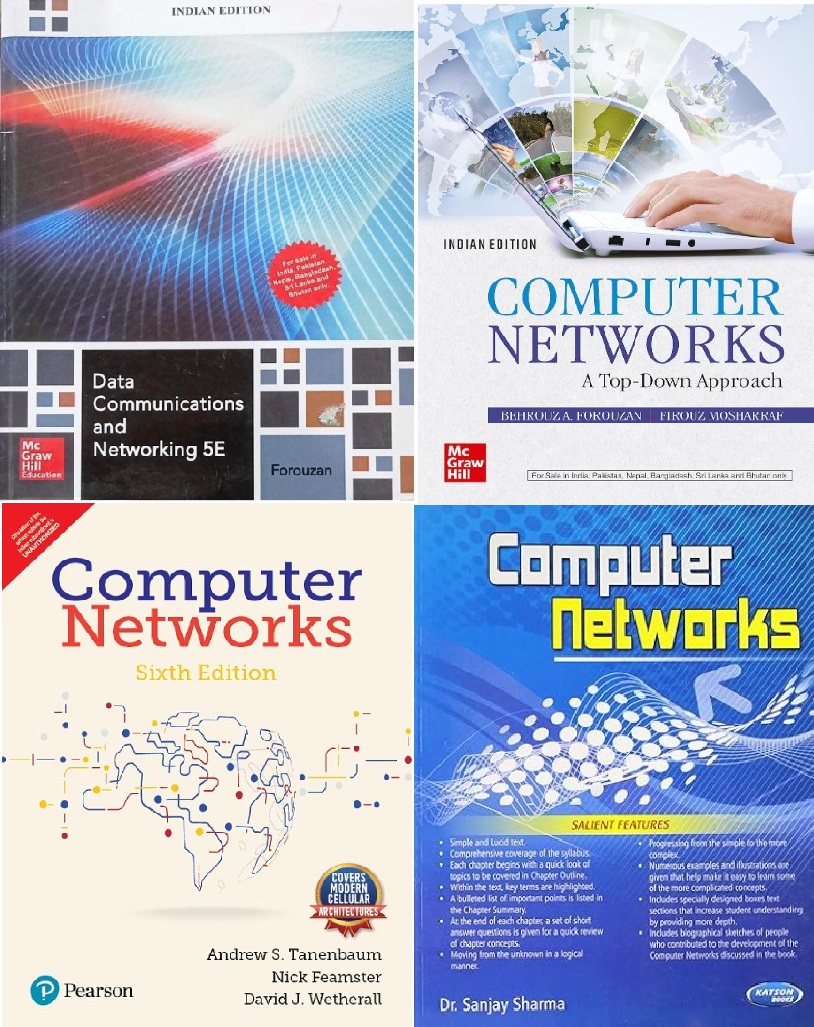UNIT 2: Physical Layer
Physical Layer: Transmission media, Signal transmission and encoding, Network performance and transmission impairments, Switching techniques and multiplexing, Overview of PSTN, ISDN, and ATM
Q81 – If the baud rate for a 64-QAM signal is 2000, what is the bit rate?
300
400
1000
12000
Ans – (4)
Explanation –
To determine the bit rate for a 64-QAM (Quadrature Amplitude Modulation) signal with a baud rate of 2000, we recognize that 64-QAM encodes 6 bits per symbol (since Log2 (64)=6). The bit rate Rb = N × baud rate, where N is the number of bits per symbol. Given the baud rate of 2000 and 64-QAM’s 6 bits per symbol, we compute the bit rate
Rb = 6 × 2000 = 12000 bps
Therefore, the bit rate for the 64-QAM signal is 12000 bits per second. This calculation demonstrates how the baud rate and the number of bits per symbol determine the overall data transmission rate for 64-QAM modulation, ensuring efficient communication of digital information.
Q82 – Given an AM radio signal with a bandwidth of 10 KHz and the highest-frequency component at 705 KHz, what is the frequency of the carrier signal?
700 KHz
705 KHz
710 KHz
Cannot be determined from given information
Ans – (1)
Explanation –
To determine the frequency of the carrier signal in an AM radio transmission, we consider the given bandwidth and the highest-frequency component. In AM radio, the carrier signal is typically located at the center of the band. Given a bandwidth of 10 KHz and the highest-frequency component at 705 KHz. The carrier frequency is determined by subtracting half of the bandwidth from the highest-frequency component, since the bandwidth extends symmetrically around the carrier. Therefore,
Fc = 705 KHz – 10KHz/2 = 700 KHz
Q83 – We need to send 265 kbps over a noiseless channel with a bandwidth of 20 kHz. How many signal levels do we need?
1024
512
256
128
Ans – (4)
Explanation –
256000 = 2 × 20000 log(L) comes to 6.625.
L is equal to 98.7 levels.
We must either decrease the bit rate or increase the number of levels because this result is not a power of two. The bit rate is 280 kbps if there are 128 levels.
Q84 – A communications device that combines transmissions from several I/O devices into one line is a
concentrator
modifier
multiplexer
full-duplex line
Ans – (3)
Explanation –
A communications device that combines transmissions from several input/output (I/O) devices into one line is known as a multiplexer.
In a scenario where you have multiple computers that need to send data to a server over one network cable, a multiplexer will take the data from each computer, combine it, and send it over the cable to the server.
Concentrator – This term is sometimes used interchangeably with multiplexer, but it generally refers to a device that gathers data from multiple sources and sends it over a single line or channel.
Modifier – This is not typically used in the context of communication devices. A modifier generally refers to something that changes or adjusts a signal, not one that combines multiple signals.
Full-duplex line – This refers to a communication channel that allows data to be sent and received simultaneously. It describes the nature of the communication link rather than a device that combines multiple signals.
Q85 – Which multiplexing technique transmits analog signals?
FDM
TDM
WDM
Both (1) and (3)
Ans – (4)
Explanation –
FDM is commonly used for transmitting analog signals. Each signal is assigned a different frequency band within the medium.
Example – Traditional radio and television broadcasting use FDM, where different channels are assigned different frequencies.
WDM can be used for transmitting analog optical signals, though it is more commonly used for digital signals in modern applications.
Example – Optical fiber communication systems often use WDM to increase the amount of data that can be sent over a single fiber.
TDM is primarily used for digital signals rather than analog signals.
Q86 – Which multiplexing technique transmits digital signals?
FDM
TDM
WDM
None of the above
Ans – (2)
Explanation –
TDM is commonly used for transmitting digital signals. Each time slot can carry a digital signal, allowing multiple digital streams to share the same communication medium.
TDM is used in digital telephony systems (like the Public Switched Telephone Network, or PSTN), where multiple phone calls are transmitted over the same line by allocating different time slots to each call.
Q87 – Which multiplexing technique shifts each signal to a different carrier frequency?
FDM
TDM
Both (1) and (2)
None of the above
Ans – (1)
Explanation –
FDM is a multiplexing technique that assigns each signal a different frequency band within the available bandwidth of the communication channel.
In FDM, each signal is modulated to a different carrier frequency, allowing multiple signals to be transmitted simultaneously without interference.
Example: Radio and television broadcasting use FDM, where different channels are transmitted at different carrier frequencies.
Q88 – In synchronous TDM, for n signal sources of the same data rate, each frame contains _______ slots.
n
n + 1
n – 1
0 to n
Ans – (1)
Explanation –
In synchronous Time Division Multiplexing (TDM), each frame is divided into a fixed number of time slots, with each slot allocated to a specific signal source.
Synchronous TDM – This type of TDM ensures that each signal source is given a dedicated time slot in each frame, regardless of whether the source has data to transmit at that moment.
n Signal Sources – If there are n signal sources, each frame will have exactly n slots, one for each source.
Q89 – In TDM, the transmission rate of the multiplexed path is usually _______ the sum of the transmission rates of the signal sources.
greater than
less than
equal to
not related to
Ans – (1)
Explanation –
In Time Division Multiplexing (TDM), the transmission rate of the multiplexed path is usually greater than the sum of the transmission rates of the individual signal sources.
Multiplexed Path – TDM combines multiple signals into a single transmission path by allocating time slots to each signal.
To accommodate all the signals within their respective time slots without causing delays or data loss, the transmission rate of the multiplexed path must be high enough to handle the sum of all the signals’ rates plus some additional overhead for synchronization and other control information.
The additional transmission rate accounts for the overhead bits and any necessary guard times between time slots to prevent interference.
Q90 – Which multiplexing technique involves signals composed of light beams?
FDM
TDM
WDM
none of the above
Ans – (3)
Explanation –
WDM is a multiplexing technique used in optical communications where multiple light signals are transmitted simultaneously over a single optical fiber by using different wavelengths (or colors) of laser light.
WDM specifically involves signals composed of light beams, making it unique among the multiplexing techniques listed. Optical fiber networks use WDM to increase the capacity of a single fiber by allowing multiple data streams to be transmitted on different wavelengths of light.
Q91 – ________ can be achieved by using multiplexing; ______ can be achieved by using spreading.
Efficiency; privacy and antijamming
Privacy and antijamming; efficiency
Privacy and efficiency; antijamming
Efficiency and antijamming; privacy
Ans – (1)
Explanation –
Multiplexing techniques, such as TDM, FDM, and WDM, are used to efficiently utilize the available bandwidth of a communication channel. By combining multiple signals into a single channel, multiplexing maximizes the use of the communication medium and increases its overall efficiency.
Spreading techniques, such as Spread Spectrum (used in technologies like CDMA), are designed to distribute a signal over a wide range of frequencies. This provides several benefits, including increased privacy (making it harder to intercept or decode the signal without the correct spreading code) and resistance to jamming (making the signal less susceptible to interference from other sources).
Q92 – ____ is designed to use the high bandwidth capability of fiber-optic cable.
FDM
TDM
WDM
None of the above
Ans – (3)
Explanation –
WDM is specifically designed to use the high bandwidth capabilities of fiber-optic cables. By using different wavelengths (or colors) of light, WDM allows multiple data streams to be transmitted simultaneously over a single fiber, greatly increasing the overall data transmission capacity.
Q93 – We can divide ____ into two different schemes: synchronous or statistical.
FDM
TDM
WDM
none of the above
Ans – (2)
Explanation –
Synchronous TDM – In this scheme, time slots are allocated to each input source in a fixed, predetermined sequence. Each source gets a dedicated time slot in every frame, regardless of whether it has data to transmit.
Statistical TDM (STDM) – Also known as Demand-Assigned TDM (DA-TDM), this scheme dynamically assigns time slots based on the availability of data from the input sources. Time slots are allocated on an as-needed basis, which can improve efficiency and adaptability in varying traffic conditions.
Q94 – _______ is designed to be used in wireless applications in which stations must be able to share the medium without interception by an eavesdropper and without being subject to jamming from a malicious intruder.
Spread spectrum
Multiplexing
Modulation
None of the above.
Ans – (1)
Explanation –
Spread spectrum spreads the signal over a wide frequency band using a spreading code. This makes the transmitted signal appear as background noise to anyone without the correct code, enhancing privacy and making it difficult for eavesdroppers to intercept the original signal.
Spread spectrum also provides resistance to intentional interference or jamming because the signal is spread across a wide bandwidth. This makes it challenging for a malicious intruder to disrupt the communication.
Q95 – Which of the following statement is incorrect?
Multiplexers are designed to accept data from several I/O devices and transmit a unified stream of data on one communication line
HDLC is a standard synchronous communication protocol
RTS/CTS is the way the DTE indicates that it is ready to transmit data and the way the DCW indicates that it is ready to accept data
RTS/CTS is the way the terminal indicates ringing
Ans – (4)
Explanation –
RTS/CTS (Request to Send)/ (Clear to Send) is not related to indicating ringing. Ringing is typically indicated by other means in telecommunications, such as a ring signal sent from the central office to a telephone device to alert of an incoming call.
Q96 – Multiplexing of different transport connections onto the same network connection is called …………….
Upward multiplexing
Downward multiplexing
Congestion control
Flow control
Ans – (1)
Explanation –
Upward multiplexing, also known as inverse multiplexing, refers to the process of combining multiple lower-speed transport connections into a single higher-speed network connection. This allows several smaller streams of data to be aggregated into a larger stream for more efficient transmission over a network.
Q97 – A single transport layer connection split and connects the different network connections is called …………………….
Upward multiplexing
Downward multiplexing
Congestion control
None of these
Ans – (2)
Explanation –
When numerous network connections are used by one transport layer connection, this is known as downward multiplexing.
In order to increase throughput, the transport layer can divide a connection across numerous channels using downward multiplexing. This kind of multiplexing is applied to networks with sluggish or low throughput.
Q98 – The difference between a multiplexer and a statistical multiplexer is
Statistical multiplexers need buffers while multiplexers do not need buffers
Multiplexer use X.25 protocol, while statistical multiplexers use the Aloha protocol
Multiplexers often waste the output link capacity while statistical multiplexers optimize its use
Multiplexers use Time Division Multiplexing (TDM) while statistical multiplexers use Frequency Division Multiplexing (FDM)
Ans – (3)
Explanation –
A multiplexer (MUX) is a device that combines multiple input signals into one output signal. It selects one of several input signals and forwards the selected input into a single line. Because each input is assigned a dedicated time slot or frequency band, traditional multiplexers can waste output link capacity when some inputs have no data to transmit during their assigned time.
A statistical multiplexer dynamically allocates bandwidth to input signals based on their demand. It is more flexible than a traditional multiplexer and can optimize the use of the output link capacity. By allocating time slots based on the presence of data, statistical multiplexers make more efficient use of the available bandwidth and reduce the waste of link capacity. Buffers are necessary to manage the data flow from multiple sources and prevent data loss.
Q99 – A network designer wants to connect 5 routers as point-to-point simplex line. Then the total number of lines required would be
2
6
10
15
Ans – (3)
Explanation –
To determine the number of lines required to connect 5 routers in a point-to-point simplex line configuration, we need to consider that each router must be connected to every other router using a separate line for each direction (since it is simplex, meaning data can only travel in one direction on each line).
The formula to calculate the number of connections (lines) needed for a fully connected network is given by the combination formula:
Number of connections = n(n−1)/2 where n is the number of routers.
Number of connections is 10.
Q100 – Privacy and anti-jamming can be achieved by
multiplexing
spreading
both a and b
None of the above
Ans – (2)
Explanation –
This technique is used in spread spectrum communication. It spreads the signal over a wider bandwidth than the minimum required. This makes the signal more resistant to interference and jamming, and it also helps to enhance privacy because the signal appears as noise to unintended receivers.



